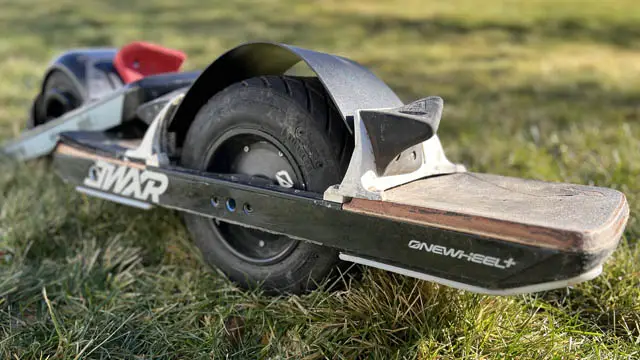Since the late 80’s, the word hoverboard has been synonymous with the movie ‘Back to the Future’. Doc Brown and Marty McFly sensationalized the world with the hoverboard then. Somehow, around 2015 a dreaded two-wheel product became very popular and was given the ‘hoverboard’ moniker. Shouldn’t the Onewheel be called a hoverboard?
A hoverboard is a two-wheeled self-balancing electric scooter that works by sensing the weight and direction of the rider. In order to maintain balance, it engages the motor in the direction of the weight. Hoverboards generally reach up to 12 miles per hour and can usually reach a range of 5 to 7 miles.

Hoverboard vs Onewheel
Why these devices get coined as ‘hoverboards’ is beyond me. If anything a Onewheel should be called a ‘hoverboard’ however its not. Clearly neither of them float, but the name is in reference to the feeling of hovering over the ground. I’d argue that the Onewheel has a far better float (hover) feel than the device we call hoverboard today. Perhaps we can call it a one wheel Segway since they are similar to Segways?
While hoverboards are self-balancing, that’s about all they have in common with One wheels. In the spirit of being too technical with terms, even the Onewheel isn’t really an electric skateboard. Electric skateboards have four wheels. So what is a Onewheel Hoverboard? technically that’s two devices in one phrase. A Onewheel is a board with a single wheel that has a sideways movement whereas a hoverboard has two wheels and rides in a perpendicular straight wheel direction. They have somewhat the same technology. They both use self balancing technology but the ride feel is so much different.
What is a Onewheel?
Onewheels are self-balancing singled-wheel electric boards. Future Motion does call them electric skateboards, but this is more for marketing as the general public typically refers to any platform with a battery as such.

So is a Onewheel an electric skateboard? Because ‘electric skateboard’ is a colloquialism that the world has gravitated to. Is a Onewheel a hoverboard? Onewheels are not hoverboards however again because of the generalizations made by the public, you will often hear Onewheels referred to as Onewheel hoverboards. Technically, the Onewheel is neither an electric skateboard or a hoverboard.
How Does a Onewheel Work?
One wheels use a a gyroscope (controller) that monitors the board’s weight and constantly attempts to balance the load by making 14,000 calculations per second. Acceleration in either direction is due to the board attempting to level the weight. Because slightly more weight is placed on one side or the other, the Onewheel will travel in that direction. This is all made possible with a motor within the hub of the one wheel. The wheel is a go-kart sized tire (pneumatic) which gives it a superior advantage over other electric board devices due to the tire diameter.
Onewheels have larger lithium-ion batteries than hoverboards and compared to most other e-skateboard devices which gives the Onewheel incredible range capabilities (up to 32 miles). Learning to ride a Onewheel is easy. Basic operation can be achieved within an hour or so.
Differences Between a Hoverboard and a Onewheel
| Attribute | Onewheel | Hoverboard |
|---|---|---|
| Self-Balancing | Yes | Yes |
| Number of Wheels | 1 | 2 |
| Top Speed | 20 (32kph) | 12mph (19kph) |
| All-terrain | Yes | No |
| Range | Up to 32mi (51.5km) | up to 7mi (11km) |
| Motor Power | 750 watts | up to 800watts |
| Tire Size | Up to 11.5″ diameter | Up to 7″ diameter |
| Foot Pads | 2 | 2 |
The similarity of a traditional hoverboard and Onewheel are that they self balance in a similar fashion and that they have two foot pads. Leaning forwards and backwards is also the way both activate the direction of the motor (no controller needed for either device). On a hoverboard, you have separate feet control with each pad.
On a Onewheel, the front footpad engages the motor. Hoverboards do this after both footpads are engaged. Where hoverboards allow the rider to travel in a frontwards manner, the Onewheel travels the rider sideways. They both work like magic in that you simply just need to lean forward to go.
Onewheel and Hoverboard Terrain Comparison
Onewheel models (from Onewheel Pint to the latest Onewheel GT) can go further due to their battery life and over many different surfaces plain and simple. Onewheels are all-terrain PEV’s. Hoverboards generally work only indoors and on asphalt or concrete. The price point of a Onewheel is dramatically higher due to this perks. For this reason, Onewheel riders tend to range from teens to adults. They are not the only PEV that can go off-road however it is one that leads in terain coverage.
Can children also ride Onewheels? While they certainly can, it is not recommended by Future Motion. My daughter learned to ride at the age of 6 and loves the Onewheel. If you have a child that has a desire to learn and is determined, they should be able to pick it up fairly quickly.
Because hoverboards are made by some many manufacturers, hoverboards have a variety of specs but their specs are fairly limited. Onewheels are currently made by Future Motion. There are VESC kits and VESC boards that are made by Floatwheel however for the most part, the Onewheel market is dominated by Future Motion at this time. Based out of Santa Cruz, Future Motion is the creator of the original Onewheel.
Max Speeds of Onewheels and Hoverboards
Onewheels are not the fastest PEV around however riders often exceed the 20mph speed that is advertised as the max speed for the Onewheel GT however you do run the risk of nosediving. This is simply the nature of a self balancing board. In similar fashion a traditional hoverboard will dump a rider when the max speed is exceeded (typically no more than 12 mph). Exceeding the max speed on either device can be dangerous and should not be attempted. Traditional e-skateboards go over 30mph however their tire profile is smaller. This means you will feel more of the cracks and bumps on the road. While electric skateboards don’t nosedive, riding at higher speeds with such small tires poses a danger in itself.
So how fast do one wheels go? They go fast enough. Onewheels and hoverboards have lower top speeds plain and simple but Onewheels can reach about twice the top speed of a Hoverboard. They still are slower than four-wheeled electric skateboards. You are taking this concession for the floating effect. You also take this concession in trade of being able to conquer crazy rough terrain (Onewheel). Riders of Onewheels know that we don’t have the fastest board on the market but they have a board that opens all a world of terrain. For me and many others, this is the priceless tradeoff.
Onewheel Product Line-up
Onewheel boards since inception
- Onewheel V1 – version 1
- Onewheel Plus (+)
- Onewheel XR – Extra Range
- Onewheel Pint
- Onewheel Pint X
- Onewheel GT
There are older versions of the Onewheel that are no longer sold such as the V1, Plus and XR. The GT is the improved flagship model. Future Motion had also issued pint-sized Onewheels called “Pint” and “Pint X” (X stands for extra range). The Future Motion brand focuses their efforts selling the Pint versions as a fun and playful compact board that can be carried around the city as you explore. Check our battery range guide for Onewheels. Essentially Future Motion offers a boards from around $1,050 to about $2,200. Within this range, the Pints are the lower price point models whereas the GT serves as the upper price range.
Onewheels have weight limits that range from 250-275 lbs. Other than that, it will come down to which board better suits you. While all can ride outdoor trails, The original Pint has a small battery and a lower top speed that makes trail riding less enjoyable but it is doable. If the cost of a board is too much, the alternatives would be to find one used or rent a Onewheel.
Onewheel Cult-ture
Onewheel was started with Kickstarter. Kickstarter exceeded the goal due to the following Onewheels had at the beginning of their sales. Since their first Onewheel in 2015, the Onewheel community exploded into a vast array of riders. From children to 60+ year old riders spanning the world, there is no other e-skate community as large.
A good indicator of the success of Onewheel is to look at the aftermarket companies that have been created. Companies such as ‘Craft and Ride’ and ‘Float Supply’ as well as the growing number of ‘Stoke Life Service’ locations popping up around the USA.
The community is like a good (in a good way) in that once you join, you don’t leave. Onewheels are a beloved belonging to the riders. Riders often customized one wheels heavily. Not just for performance but as an outlet for expression. From helmet to board, each rider usually has their uniqueness making it easy to spot them in a ride. You don’t mistakenly grab the wrong board on a group ride. Each board is typically so unique, this is highly unlikely to do.
If you ever want to find Onewheelers near your area. You can’t search google for Onewheel near me however you can download the Onewheel App and find the best trails around your area.
Hoverboards Lack Community
Sales across all hoverboards do exceed Onewheel sales however because hoverboard has so many different manufacturers, the scant following is stratified across several brands. Yes, this is a personalization benefit however there is little cohesiveness among the hoverboard community.
Onewheel riders are close knit (for the most part). In ways, Id say its similar to joining a club. No other board sport really has this other than skateboarding and I think a lot of what Onewheel sees is from that community. Its interesting to note however that other electric skateboards do not have the same following as the beloved self-balancing electric skateboard we know as Onewheel.
Join the Onewheel Club
If you found this post looking to see the differences between a hoverboard and a Onewheel, I hope that I have sparked some intrigue regarding how amazing Onewheels are. They simply are so much fun and can go almost anywhere. Please see my post on what is needed to get started Onewheeling.
This site covers base safe riding principles that should keep you from being scared of balancing on one wheel. If you want to have fun by simply riding a random street, you’ll find it with a Onewheel. Get on one today and unlock the hidden fun surrounding your home.
F.A.Q.’s
Technically these are separate devices. A Onewheel is a self-balancing electric board whereas a hoverboard is a self-balancing two-wheeled device. Both similarly use gyroscopes to balance the rider.
No. Generally Onewheels have notably superior specs which outperform most hoverboards.
Both balance a rider. A rider has similar risk exposure on a Onewheel to a hoverboard. It is important to understand the proper functionality and operation of each device prior to use.
The best place to find honest Onewheel reviews is to join a Onewheel online community.

One thought on “Onewheels are Not Hoverboards”